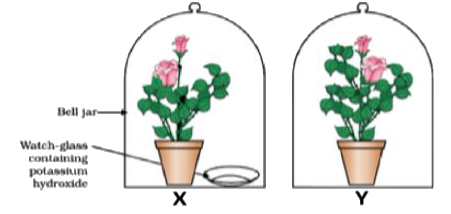Assertion: Both natural and synthetic auxins have been used extensively in agricultural and horticultural practices.
Reason: Auxin is widely applied in tea plantations and
hedge-making.
If both assertion and reason are true and the reason is the correct explanation of the assertion.
If both assertion and reason are true but reason is not the correct explanation of the assertion.
If assertion is true but reason is false.
If both assertion and reason are false.
The correct Answer is:C
Both natural and synthetic auxins have been used ex tensively in agricultural and horticultural practices.
.. Decepitation is widely applied in tea planations and hedge making.
Topper's Solved these Questions
- PLANT GROWTH AND DEVELOPMENTBOOK - A2ZCHAPTER - PLANT GROWTH AND DEVELOPMENTEXERCISE - Section C : Previous Years' Examination Questions (NEET /AIPMT Questions)
66 Videos
- PLANT GROWTH AND DEVELOPMENTBOOK - A2ZCHAPTER - PLANT GROWTH AND DEVELOPMENTEXERCISE - Section C : Previous Years' Examination Questions (AIIMS Questions )
19 Videos
- PLANT GROWTH AND DEVELOPMENTBOOK - A2ZCHAPTER - PLANT GROWTH AND DEVELOPMENTEXERCISE - Section A : Topicwise Questions Topic 5 : Photoperiodism And Vernalisation
40 Videos
- PHOTOSYNTHESIS IN HIGHER PLANTSBOOK - A2ZCHAPTER - PHOTOSYNTHESIS IN HIGHER PLANTSEXERCISE - Section D : Chapter End Test
50 Videos
- PLANT KINGDOMBOOK - A2ZCHAPTER - PLANT KINGDOMEXERCISE - Section-d Chapter-end Test
50 Videos
Similar Questions
Write the process that result in the growth of lateral buds and widely applied in tea plantations and hedge making.
View SolutionIn this section each item consists of six sentences of a passage. The first and the sixth sentences are given in the beginning as S1 and 56. The middle four sentences in each have been jumbled up and labelled as P, Q, R and S. You are required to find out the proper sequence of the four sentences and mark your response accordingly on Answer Sheet.
S1: Biology is the youngest of the formalized disciplines of natural science.
S6: Life expectancy of human beings has dramatically changed over the years.
P: However, the twentieth century and certainly the twenty-first century has demonstrated the utility of biological knowledge in furthering human welfare, be it in health sector or agriculture.
Q: The discovery of antibiotics, and synthetic plant-derived drugs, anaesthetics have changed medical practice on one hand and human health on the other hand,
R: Applications of physics and chemistry in our daily life also have a higher visibility than those of biology
S: Progress in physics and chemistry proceeded much faster than in biology.
The correct sequence should be
View Solution
Knowledge Check
Assertion : 2,4-D is extensively used in agricultural and horticultural practies.
Reason : 2,4-D is a herbicide.AIf both assertion and reason are true and reason is the correct explanation of assertionBIf both assertion and reason are true but reason is not the correct explanation of assertionCIf assertion is true but reason is falseDIf both assertion and reason are falseAssertion : 2, 4-D is widely used by farmers in agricultural and horticultural practices.
Reason : Flowering in most plants can be intiated by using high concerntration of auxin.AIf Both Assertion & Reason are true and the reason is the correct explanation of the assertion, then mark (1)BIf both Assertion and reason are true but the reason is not the correct explanation of the assertion, then mark (2).CIf Assertion is true statement but reason is false, then mark (3)DIf both Assertion and reason are false statements, then mark (4).Assertion: Soil is polluted through use of weedicides to remove weeds.
Reason: Agricultural chemicals (like insecticides and pesticided) are toxic and extremely harmful, to human beings and animals alike, and have been polluting environment (soil,ground water), fruits, vegetables and crop plants.AIf both assertion and reason are trueand the reason is the correct explanation of the assrertion.BIf both assertion and reason are true but reason is not the correct explanation of the assertion.CIf assertion istrue but reason is false.DIf both assertion and reason are false.
Auxins are growth hormones caplable of promoting cell elongation. They have been used in horticulture to promote growth flowerin g and rooting wirte a line to explain the meaning of the following terms related to auxins
(a) Auxins precursors ,(b) Anti auxins, (c ) Synthetic auxins
View SolutionThe Figure shown below represents an activity to prove the requirements for photosynthesis. During this activity, two healthy potted plants were kept in the dark for 72 hours. After 72 hours, KOH is kept in the watch glass in setup X and not in setup Y. Both these setups are air tight and have been kept in light for 6 hours. Then, Iodine Test is performed with one leaf from each of the two plants X and Y.

Which of the following steps can be followed for making the apparatus air tight?
i. placing the plants on glass plate
ii. using a suction pump.
iii. applying aseline to seal the bottom of jar.
iv. creating vacuum
View SolutionTwo hundred years after Malthus predicted that population growth would overtake food production by a margin of 256 to 9, the simple fact is that food production had always been ahead of the population growth. Malthus' doomsday prediction simply did not come true due to two major reasons: first, population did not grow geometrically and birth rates in all Western countries fell during the 20th Century, resulting in very slow population growth. Over the past quarter century, birth rates have been falling in the developing countries too. Second, modern agricultural practices and better irrigation have resulted in tremendous growth in food production in almost all parts of the globe, with the notable exception of sub-Saharan Africa. Therefore, at the global level, the Malthusian doomsday never befell on us.
India's population grew by about two and a half times in the past 45 years from 361 million in 1951 to an estimated 916 million in 1995. But during the same period, India's food-grain production grew by nearly four times - from 51 million tonnes in 1951 to 191 million tonnes in 1995. As a result, the per capita food grain availability in India has gone up considerably since the independence. That is, the Malthusian prediction has not come true even in India.
India's food production from 1951 to 1995 grew nearly
View SolutionTwo hundred years after Malthus predicted that population growth would overtake food production by a margin of 256 to 9, the simple fact is that food production had always been ahead of the population growth. Malthus' doomsday prediction simply did not come true due to two major reasons: first, population did not grow geometrically and birth rates in all Western countries fell during the 20th Century, resulting in very slow population growth. Over the past quarter century, birth rates have been falling in the developing countries too. Second, modern agricultural practices and better irrigation have resulted in tremendous growth in food production in almost all parts of the globe, with the notable exception of sub-Saharan Africa. Therefore, at the global level, the Malthusian doomsday never befell on us.
India's population grew by about two and a half times in the past 45 years from 361 million in 1951 to an estimated 916 million in 1995. But during the same period, India's food-grain production grew by nearly four times - from 51 million tonnes in 1951 to 191 million tonnes in 1995. As a result, the per capita food grain availability in India has gone up considerably since the independence. That is, the Malthusian prediction has not come true even in India.
In the developing countries, the birth rate is
View SolutionCase : The Figure shown below represents an activity to prove the requirements for photosynthesis. During this activity, two healthy potted plants were kept in the dark for 72 hours. After 72 hours, KOH is kept in the watch glass in setup X and 'not in setup Y. Both these setups are air tight and have been kept in light for 6 hours. Then, lodine Test is performed with one leaf from each of the two plants X and Y.

Which of the following steps can be followed for making the apparatus air tight?
(I) placing the plants on glass plate
(II) using a suction pump.
(III) applying aseline to seal the bottom of jar.
(IV) creating vacuum
View Solution